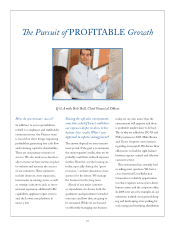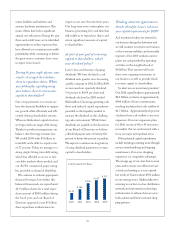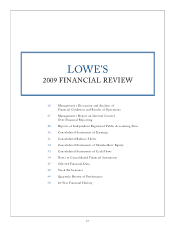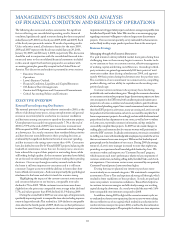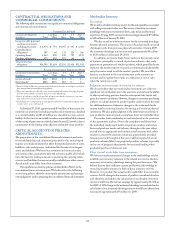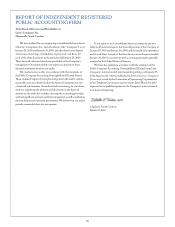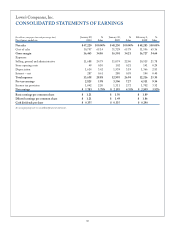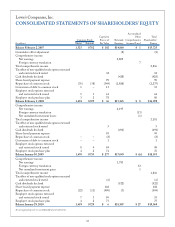Lowe's 2009 Annual Report Download - page 27
Download and view the complete annual report
Please find page 27 of the 2009 Lowe's annual report below. You can navigate through the pages in the report by either clicking on the pages listed below, or by using the keyword search tool below to find specific information within the annual report.
25
We have not made any material changes in the methodology
used to recognize vendor funds during the past three years. If actual
results are not consistent with the assumptions and estimates used,
we could be exposed to additional adjustments that could positively
or negatively impact gross margin and inventory. However, substantially
all receivables associated with these activities do not require subjective
long-term estimates because they are collected within the following year.
Adjustments to gross margin and inventory in the following year have
historically not been material.
Long-Lived Asset Impairment – Operating Stores
Description
At January 29, 2010, $19.2 billion of our long-lived assets were
associated with stores currently in operation. We review the carrying
amounts of operating stores whenever events or changes in circum-
stances indicate that the carrying amounts may not be recoverable.
When evaluating operating stores for impairment, our asset group is
at an individual store level, as that is the lowest level for which cash
flows are identifiable. Cash flows for individual operating stores do
not include an allocation of corporate overhead.
We evaluate operating stores on a quarterly basis to determine when
store assets may not be recoverable. Our primary indicator that oper-
ating store assets may not be recoverable is consistently negative cash
flow for a 12 month period for those stores that have been open in the
same location for a sufficient period of time to allow for meaningful
analysis of ongoing operating results. Management also monitors other
factors when evaluating operating stores for impairment, including
individual stores’ execution of their operating plans and local market
conditions, including incursion, which is the opening of either other
Lowe’s stores or direct competitors’ stores within the same market.
For operating stores, a potential impairment has occurred if
projected future undiscounted cash flows expected to result from the
use and eventual disposition of the store assets are less than the carry-
ing amount of the assets. When determining the stream of projected
future cash flows associated with an individual operating store, manage-
ment makes assumptions, incorporating local market conditions, about
key store variables including sales growth rates, gross margin and con-
trollable expenses, such as store payroll and occupancy expense.
An impairment loss is recognized when the carrying amount of
the operating store is not recoverable and exceeds its fair value. We
generally use an income approach to determine the fair value of our
individual operating stores, which requires discounting projected
future cash flows. is involves making assumptions regarding both
a store’s future cash flows, as described above, and an appropriate
discount rate to determine the present value of those future cash
flows. We discount our cash flow estimates at a rate commensurate
with the risk that selected market participants would assign to the
cash flows. e selected market participants represent a group of
other retailers with a store footprint similar in size to ours.
We recorded operating store impairment losses of $53 million
during 2009 compared to $16 million during 2008.
Judgments and uncertainties involved in the estimate
Our impairment loss calculations require us to apply judgment in
estimating expected future cash flows, including estimated sales,
margin and controllable expenses and assumptions about market
performance. We also apply judgment in estimating asset fair values,
including the selection of an appropriate discount rate.
Effect if actual results differ from assumptions
We have not made any material changes in the methodology used
to estimate the future cash flows of operating stores during the past
three years. If the actual results of our operating stores are not
consistent with the assumptions and judgments we have made in
estimating future cash flows and determining asset fair values, our
actual impairment losses could vary positively or negatively from
our estimated impairment losses. A 10% reduction in projected sales
used to estimate future cash flows at the time that the operating stores
were evaluated for impairment would have increased recognized
impairment losses by $31 million. A 10% increase in projected sales
used to estimate future cash flows at the time that the operating stores
were evaluated for impairment would have reduced recognized
impairment losses by $3 million. We analyzed other assumptions
made in estimating the future cash flows of the operating stores
evaluated for impairment, but the sensitivity of those assumptions
was not significant to the estimates.
Self-Insurance
Description
We are self-insured for certain losses relating to workers’ compensation,
automobile, property, general and product liability, extended warranty,
and certain medical and dental claims. Self-insurance claims filed and
claims incurred but not reported are accrued based upon our estimates
of the discounted ultimate cost for self-insured claims incurred using
actuarial assumptions followed in the insurance industry and historical
experience. During 2009, our self-insurance liability increased
approximately $41 million to $792 million as of January 29, 2010.
Judgments and uncertainties involved in the estimate
ese estimates are subject to changes in the regulatory environment;
utilized discount rate; projected exposures including payroll, sales,
and vehicle units; as well as the frequency, lag and severity of claims.
Effect if actual results differ from assumptions
We have not made any material changes in the methodology used to
establish our self-insurance liability during the past three years. Although
we believe that we have the ability to reasonably estimate losses related
to claims, it is possible that actual results could differ from recorded
self-insurance liabilities. A 10% change in our self-insurance liability
would have affected net earnings by approximately $50 million for 2009.
A 100 basis point change in our discount rate would have affected net
earnings by approximately $14 million for 2009.


